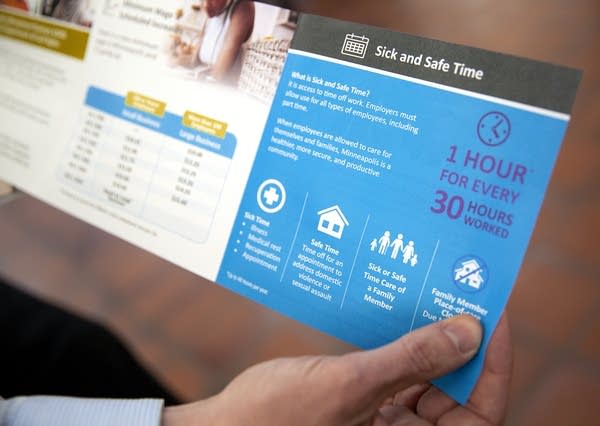Supreme Court upholds Minneapolis sick time ordinance

Go Deeper.
Create an account or log in to save stories.
Like this?
Thanks for liking this story! We have added it to a list of your favorite stories.
Updated: 3:55 p.m.
Minneapolis is allowed to require paid sick leave for employees in the city, even those who work for businesses based outside of Minneapolis, the Minnesota Supreme Court ruled Wednesday.
The 5-2 ruling rejects an appeal by the Minnesota Chamber of Commerce, which argued that state law preempted cities such as Minneapolis from enacting paid leave. It also rejected the Chamber’s argument that Minneapolis could only regulate businesses that were based in the city.
“A business does not need to have an office location within Minneapolis to be subject to the city’s regulatory powers,” wrote Justice Natalie Hudson in the majority opinion. “If employers send their employees to perform work within Minneapolis, the employers must obey the city’s regulations, regardless of whether they have offices within Minneapolis or not.”
The paid leave ordinance requires businesses give employees at least one hour of “sick and safe time” for every 30 hours of work, provided those employees work inside Minneapolis for at least 80 hours per year. It went into full effect in 2019, after an appeals court ruled in the city’s favor and lifted an injunction against imposing the ordinance on firms based outside the city.
Turn Up Your Support
MPR News helps you turn down the noise and build shared understanding. Turn up your support for this public resource and keep trusted journalism accessible to all.
Minneapolis City Council President Lisa Bender, who co-wrote the paid leave ordinance, said she was “thrilled” that the ruling upheld the mandatory sick leave for “thousands of workers in Minneapolis,” including those working for businesses based elsewhere.
“We don't want to create loopholes for businesses to get out from offering safe and sick time protections to their workers,” Bender said.
The Chamber’s President Doug Loon called the ruling “a blow to all employers in Minnesota.”
“Benefit packages are designed as uniquely as the employees they are meant to attract,” Loon said. “One city unilaterally deciding workplace policies — inside and outside their borders — is a significant burden and just plain overreach.”
Gov. Tim Walz on Wednesday supported the court ruling and said it’s time to pass a statewide standard for paid leave.
“I do think the businesses community’s fear of patchwork of regulations is a legitimate concern. I simply take a very strong position of not preempting local authority when you can help it,” Walz said during a press conference as he announces a special session. “But when you see what’s happening in COVID-19, it helps if we have a unified strategy.”
Ruling drew on century-old cases
The court ruled on two primary points: whether Minneapolis was allowed to mandate paid leave without specific authorization from the state, and whether what’s called the “extraterritoriality doctrine” prevented Minneapolis from imposing such a regulation on businesses based elsewhere.
The extraterritoriality issue was the primary focus of the case, having divided lower courts before the Supreme Court’s ruling. Justices looked at the two prior instances in which the Supreme Court had ruled on cities’ powers beyond their borders: an 1896 case upholding Minneapolis’ ability to mandate health inspections of farms providing milk for sale in the city, and a 1911 case blocking Duluth’s attempt to ban the storage of explosives within one mile of the city limits.
Based on these rulings, the majority opinion found that the Minneapolis ordinance “primary purpose” was to regulate actions inside the city, and didn’t violate the extraterritoriality doctrine.
Justice G. Barry Anderson dissented from this conclusion, writing that precedent had established cities could only affect things outside their borders when they had explicit “statutory authority to act,” not merely broad powers to promote the “general welfare.” Without such a state law, Anderson wrote in a dissent joined by Chief Justice Lorie Gildea, Minneapolis could only affect businesses based within its borders.
Dissenting opinions don’t establish binding legal precedents.
The other ruling, that Minneapolis wasn’t preempted from mandating sick leave, was based on a legal grey area. State law neither explicitly allowed Minneapolis to mandate paid leave nor forbade it, but the Chamber argued that the state had implicitly forbidden such action by cities.
For example, a state law regulating cases where an employer does grant sick leave, the Chamber argued, implies the possibility of a business not offering sick leave, and thus prevents cities from offering it. The court rejected that argument. Minneapolis’s ordinance is “additional and complementary” to state law, not in conflict with it, Hudson wrote.
Anderson’s dissent did not address questions of preemption.
Decision could have broad implications
The court’s ruling strengthens the ability of cities to impose requirements on businesses operating inside their boundaries. After Minneapolis passed its paid leave ordinance in 2016, other cities including St. Paul and Duluth passed similar measures. Minneapolis and other cities have also passed regulations governing wage theft and setting higher minimum wages, and Minneapolis has considered so-called “fair scheduling” regulations requiring businesses to give workers their schedules in advance.
Bender said the ruling strengthens Minneapolis’s efforts to regulate businesses by making it “harder for employers to get out of worker protections by moving their headquarters out of cities that protect workers.”
Loon said the Supreme Court’s ruling “impedes economic growth” by creating a “patchwork” of laws from city to city. He called on the state legislature to pass new laws governing “the boundaries of regulation.”



